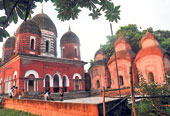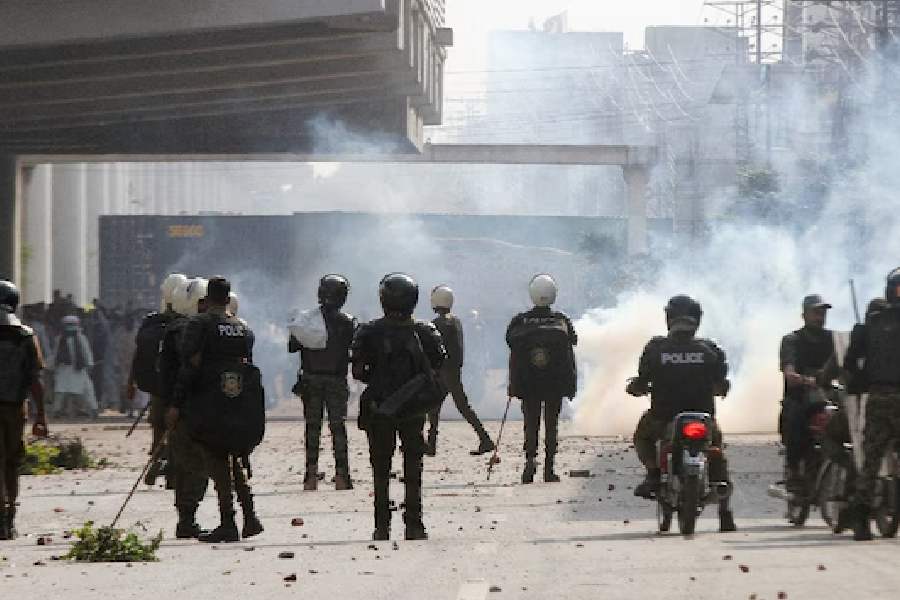 |
 |
 |
| (From top) Trananath Banerjee’s Kali temple with three Shiva temples on the premises; the single-storey house with its tiled roof in Penetir Bagaan with the main house in the background; Hooghly through the arches of the Kali temple. Pictures by Sanjoy Chattopadhyaya |
Some places about whose geographical location there cannot be even a grain of doubt, somehow gain mythical status in public imagination. To those who have read Rabindranath Tagore’s autobiographical writings — Jiban Smriti and Chhelebela — Penetir Bagaan or a garden house in Panihati, is much more than a real garden near Sodepur. It is like Eden.
The Sodepur crossing of BT Road is busy even at 10pm. On its left is a rickshaw stand, beside which is a police kiosk, and adjacent to it is a narrow road that snakes all the way to the river bank. On both sides are dwelling houses, one uglier than the other, and ponds, one of which has been turned into a swimming pool. Most old houses are falling to pieces. At what seems the end of the road is a large gate with the words Govinda Kumar Home painted on it with white. As in most old places, ancient houses have either disappeared or else they are turning into heaps.
The first thing that is visible as one enters through the gate is a single-storey house with a neat tiled roof. On the right of the gate is a small pond surrounded by trees that create a screen of leaves. As one walks along the pathway, a larger house in the distance becomes visible through the leafy lattice work. It is a freshly painted double-storeyed house separated from the smaller one by a tiny field, where scores of little girls roam around. Beyond the field is a row of huge trees and glimmering through them is the Hooghly. The ghat is shaded by trees. Coconut trees rise way above the larger house.
This is the garden in Panihati where the child Rabindranath along with his family had sought refuge for some time during a dengue epidemic. That was the first time that the 12-year-old poet had ever left his Chitpur home to come face-to-face with nature and greenery in a Bengal village. Rabindranath’s account of his stay is inscribed verbatim on a marble plaque installed next to the house with a tiled roof, under which stands a bust of the poet.
The mental picture conjured up by Rabindranath’s lines comes very close to the reality. I visited the garden that once belonged to Chhatubabu or Asutosh Deb, the well-known merchant, on a monsoon evening, when the sun was setting in a blaze of red and gold. There is some controversy over the ownership of this beautiful property and Prashanta Pal had referred to it in his biography Rabi Jibani. He says Rabindranath had referred to this garden as being the property of one Lalababu, whose identity remains vague, although it is fairly clear that he is not the famous Krishnachandra Sinha of Paikpara Rajbari.
Rabindranath’s niece Sarala Debi Chaudhurani had written that the property belonged to Debendranath Tagore, while rent bills available refer to the landlady Upendramohini Dassi. Her annaprashan or rice ceremony was held in the garden. Controversy apart, Chhatubabu himself had breathed his last here, his body touching the water of Hooghly to ensure his passage to heaven. It is said that Tagore had visited the garden much later in life as well.
Sunil Pal, 75, former chairman of Panihati municipality, says Lalchand Mallik had bought the garden from Chhatubabu, and later, Gopal Das Choudhury, the zamindar of Sherpur in Mymensinh, had acquired the property covering nine bighas. He opened a home for fallen women here which he named after his father, Gobinda Das. Now it is meant for underage girls from impoverished families.
The big house, where the 85 girls live, looks brand new. The original house was killed with care. A blue plaque declares that it is a “heritage building” but those who have repaired it have done more damage to it than vandals possibly could.
The roof was falling to pieces, so it was concretised. The capital of the Ionic columns has been transformed to something close to flattened lotus blossoms. The original wooden staircase was replaced by a concrete one some time ago. The fanlights were erased and much of the woodwork has been removed.
Behind the house is a magnificent Kali temple with five towers constructed by Trananath Banerjee, the local zamindar who had formed Panihati municipality way back in 1900. The street that passes by the home and the temple are named after this man who has no descendants. His house further down is occupied by squatters. Old men who sit on the ghat say that the temple had beautiful terracotta ornaments. Most of these were removed when the temple was repaired.











